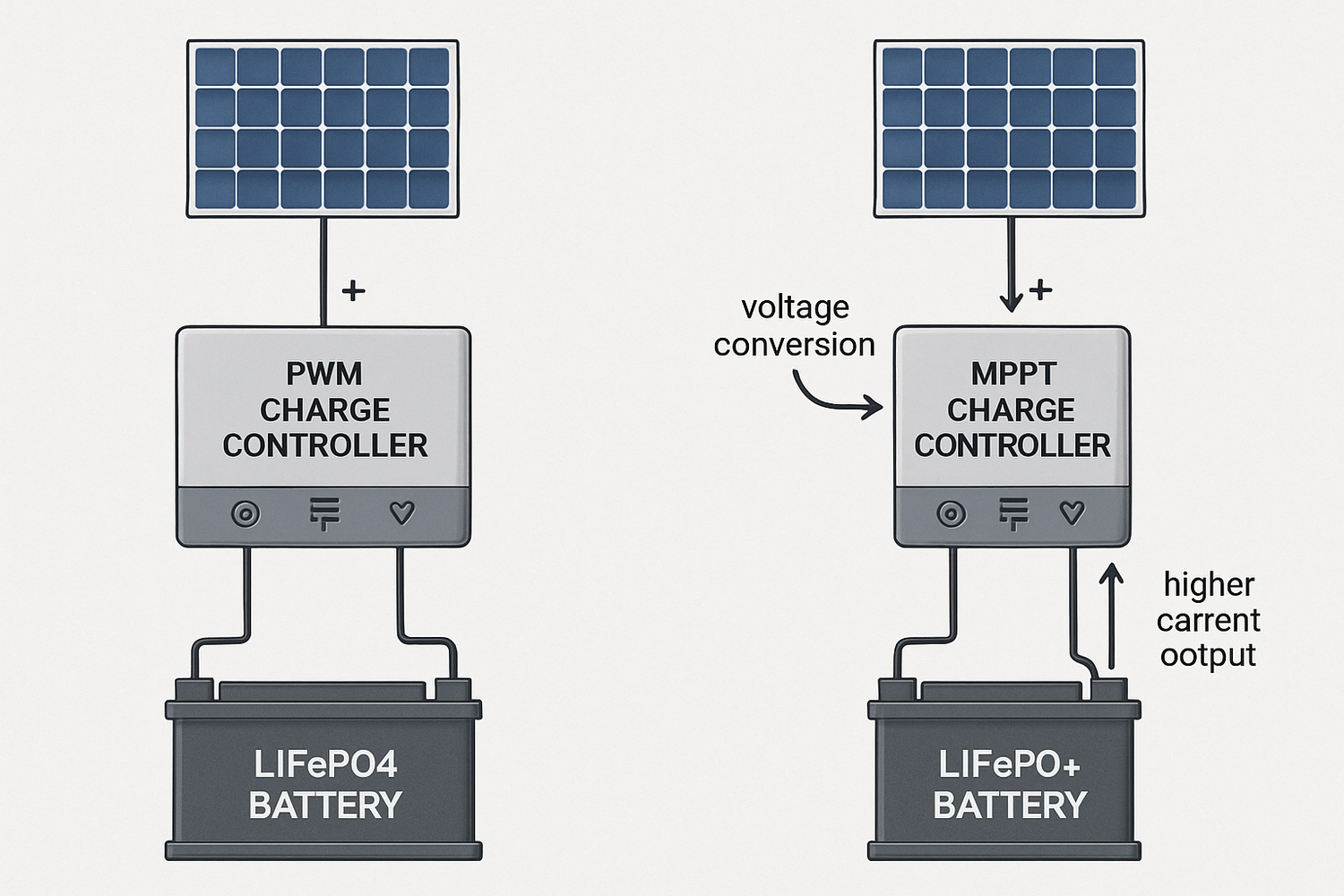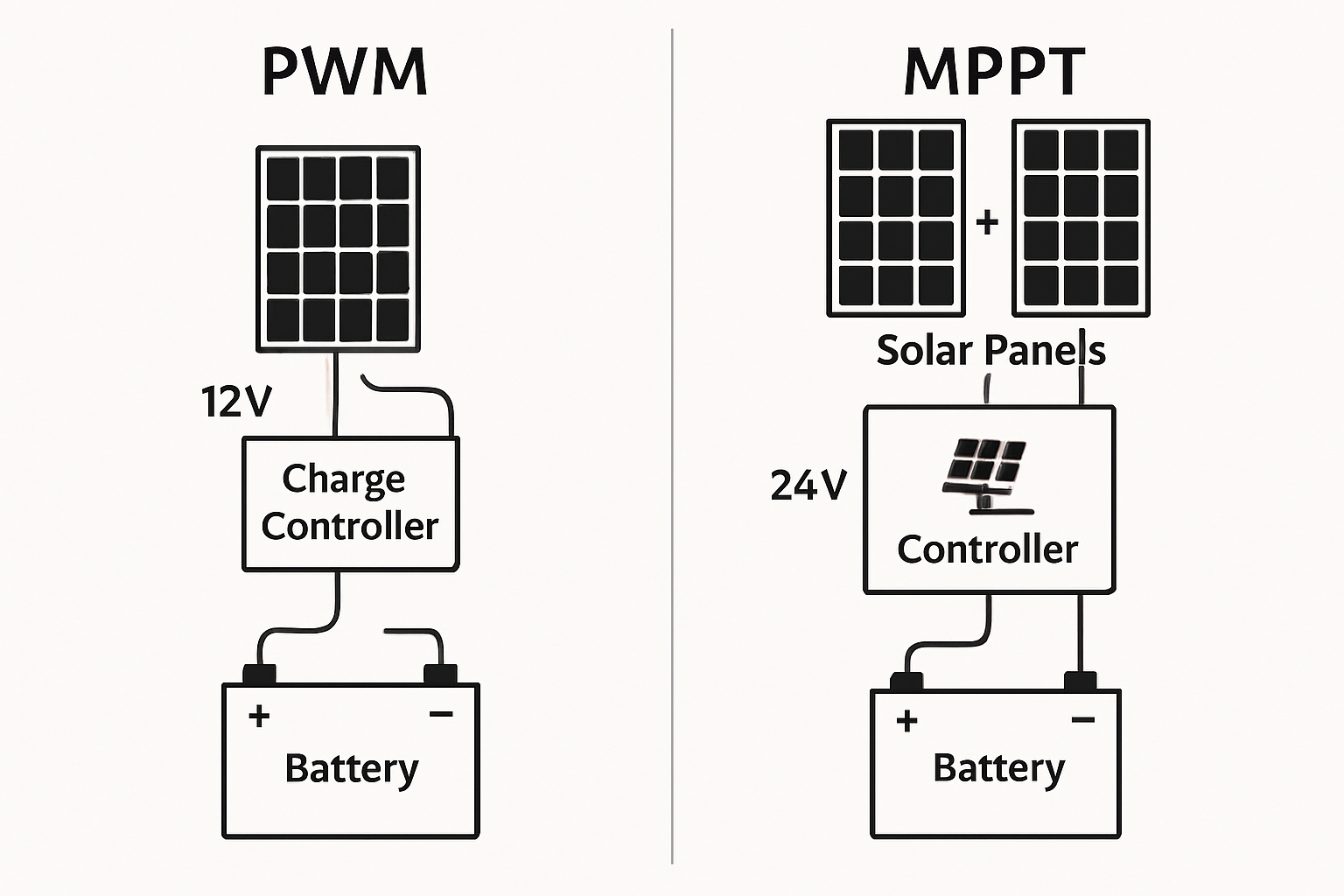Selecting the right solar charge controller is a critical decision for any solar power system. This component acts as the gatekeeper for your battery bank, regulating the power from your solar panels to ensure safe and efficient charging. For systems using advanced Lithium Iron Phosphate (LiFePO4) batteries, this choice is even more significant. The two dominant technologies on the market are Pulse Width Modulation (PWM) and Maximum Power Point Tracking (MPPT). While both manage battery charging, they do so with vastly different approaches and results. Understanding these differences is key to maximizing the performance and lifespan of your LiFePO4 battery investment.
Understanding the Core Technologies: PWM and MPPT
At a fundamental level, both controllers protect your batteries from overcharging. However, their methods for achieving this are what set them apart, directly impacting system efficiency and flexibility.
Pulse Width Modulation (PWM) Explained
A PWM controller is the simpler of the two technologies. It functions like a sophisticated switch, connecting the solar array directly to the battery bank. As the battery charges, the controller rapidly switches on and off to taper the current and maintain the battery at a safe voltage. This method is straightforward and effective for basic protection. Because of its simpler design, PWM controllers are generally more affordable and smaller in size. However, they require the nominal voltage of the solar panel array to match the nominal voltage of the battery bank (e.g., a 12V panel for a 12V battery).
Maximum Power Point Tracking (MPPT) Explained
An MPPT controller is a more advanced and complex device. It operates as a smart DC-to-DC converter that can decouple the solar panel voltage from the battery voltage. This technology continuously scans the panel's output to find the 'maximum power point'—the ideal combination of voltage and current that yields the most power. It then converts this maximum power to the optimal voltage for charging the battery. Essentially, it transforms excess panel voltage into additional charging current, a feat PWM controllers cannot perform. This process can boost energy harvest by up to 30% compared to PWM controllers, especially in variable weather conditions.
Key Differences in Performance for LiFePO4 Systems
When paired with a LiFePO4 battery bank, the technological differences between PWM and MPPT translate into significant performance disparities. LiFePO4 batteries are a substantial investment, and the charge controller plays a vital role in unlocking their full potential.
Efficiency and Power Harvest
The primary advantage of an MPPT controller is its superior efficiency. Consider a solar panel with a maximum power voltage (Vmp) of 18V connected to a 12V LiFePO4 battery. A PWM controller will pull the panel's voltage down to match the battery's charging voltage (around 14.4V), wasting the extra voltage. In contrast, an MPPT controller takes the full 18V output, converts the excess voltage (18V - 14.4V) into more current, and delivers it to the battery. This results in significantly faster and more complete charging cycles. The performance gains are especially noticeable in conditions that affect panel voltage, such as low light or cold temperatures. For a deeper dive into how different components affect system output, the Ultimate Reference for Solar Storage Performance provides valuable data on optimizing your entire setup.
System Sizing and Flexibility
MPPT controllers offer far greater flexibility in system design. Because they can step down a higher voltage, you can use more readily available and often less expensive grid-tie solar panels (which have higher voltages) to charge a 12V, 24V, or 48V battery bank. This also allows you to wire panels in series for a higher voltage array. Higher voltage transmission is more efficient over long cable runs, as it reduces power loss and allows for the use of thinner, less expensive wiring. PWM controllers lack this flexibility, locking you into a system where panel and battery voltages must match.
Temperature Considerations
Solar panels perform better in cold weather, producing a higher voltage than their standard rating. An MPPT controller can capture this extra voltage and convert it into additional charging current, leading to a significant power boost during winter months. A PWM controller cannot capitalize on this effect and will simply discard the extra power potential. Since LiFePO4 batteries require careful management, especially during charging in cold conditions, the precise control offered by a high-quality MPPT controller is highly beneficial.
Making the Right Choice: A Practical Decision Framework
Choosing between PWM and MPPT should be based on your system's size, goals, and budget. While one has a lower upfront cost, the other provides superior long-term value, particularly for LiFePO4 batteries.
When to Choose a PWM Controller
A PWM controller can be a suitable choice under a few specific circumstances:
- Very Small Systems: For small-scale applications, like a single panel under 170W for trickle charging or powering minor loads, the cost savings of a PWM might be justified.
- Strict Budget Constraints: When the initial cost is the absolute primary factor and efficiency losses are acceptable.
- Perfect Voltage Match: In systems where the solar panel's nominal voltage is a perfect match for the battery's voltage and weather conditions are consistently warm and sunny.
When an MPPT Controller is the Clear Winner
For the vast majority of systems utilizing LiFePO4 battery banks, an MPPT controller is the superior investment:
- Maximizing Power Harvest: If your goal is to get the most energy possible from your solar array, MPPT is the only choice.
- Large Solar Arrays: Any system over 200 watts will see substantial benefits from MPPT technology.
- Voltage Mismatch: When using higher voltage panels to charge a lower voltage battery bank.
- Variable Weather: In locations with frequent cloudy days, low light, or cold temperatures, an MPPT controller will significantly outperform a PWM.
| Feature | PWM (Pulse Width Modulation) | MPPT (Maximum Power Point Tracking) |
|---|---|---|
| Efficiency | Lower (typically 70-85%) | Higher (typically 95-99%) |
| Power Harvest | Good | Excellent (up to 30% more) |
| System Flexibility | Low (Panel voltage must match battery voltage) | High (Can use higher voltage panels) |
| Performance in Cold | Standard | Excellent (Captures extra voltage) |
| Cost | Low | Higher |
| Best For | Small, budget-sensitive systems | Most systems, especially with LiFePO4 batteries |
The Financial Aspect: Cost vs. Value
While MPPT controllers have a higher initial purchase price, it's more accurate to view them as a long-term investment. The efficiency gains mean you can generate the same amount of power with a smaller solar array, potentially offsetting the controller's higher cost. Over the system's lifespan, the additional power harvested by an MPPT controller translates into real financial savings and a faster return on your solar investment. As the International Renewable Energy Agency (IRENA) notes in its Electricity Storage Valuation Framework, properly assessing the value of storage is crucial, and maximizing the energy into that storage with an efficient controller is a key part of that equation. Efficient charging contributes to better overall system economics and viability.
Final Thoughts
For a LiFePO4 battery bank, the choice is clear. These batteries are a premium component in a modern energy storage system, and pairing them with a less efficient PWM controller is like putting budget tires on a high-performance car. You simply won't get the performance you paid for. An MPPT solar charge controller ensures you harvest the maximum possible energy from your solar panels, provides greater design flexibility, and ultimately offers the best protection and performance for your valuable battery bank. It is the recommended choice for anyone serious about building a reliable and efficient solar energy solution.
Frequently Asked Questions
Can I use a PWM controller with LiFePO4 batteries?
Technically, yes, but only if the PWM controller has a specific charging profile designed for LiFePO4 chemistry. However, it is not recommended because you will lose a significant amount of potential power generation compared to an MPPT controller, and the charging will be less precise.
How much more power can an MPPT controller really generate?
Under optimal conditions, such as on cold, sunny days or when the solar panel voltage is significantly higher than the battery voltage, an MPPT controller can harvest 10-30% more power than a PWM controller. This increased yield leads to faster charging and more available energy.
Does an MPPT controller extend the life of my LiFePO4 battery?
Indirectly, it can. A high-quality MPPT controller provides a more precise and optimized charging algorithm. By consistently ensuring the battery is charged under ideal conditions and preventing chronic undercharging, it helps maintain the battery's health, which can contribute to a longer operational lifespan.



![Is an MPPT Solar Controller Worth the Extra Cost? [Analysis]](http://www.anernstore.com/cdn/shop/articles/Diagram_comparing_PWM_and_MPPT_solar_charge_contro.png?v=1761102210&width=1536)

Leave a comment
All comments are moderated before being published.
This site is protected by hCaptcha and the hCaptcha Privacy Policy and Terms of Service apply.